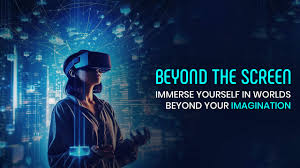info@gladsme.in
+91.8891968718
Virtual Reality (VR) 2.0: The Next Frontier in Immersive Technology
Virtual Reality (VR) 2.0: The Next Frontier in Immersive Technology

Virtual Reality (VR) 2.0: The Next Frontier in Immersive Technology
Virtual Reality (VR) has come a long way since its inception. As we step into the era of VR 2.0, the technology promises to revolutionize our interaction with digital environments, making them more immersive, interactive, and indistinguishable from reality. In this blog post, we'll explore what VR 2.0 entails, its advancements, and its potential impact on various sectors.
What is VR 2.0?
VR 2.0 refers to the next generation of virtual reality technology, characterized by significant improvements in hardware, software, and user experience. These advancements include higher resolution displays, more accurate motion tracking, and enhanced haptic feedback, creating a more convincing and engaging virtual environment.
Key Advancements in VR 2.0
1. Improved Visual Fidelity
One of the standout features of VR 2.0 is the leap in visual quality. New headsets offer higher resolution displays, wider fields of view, and faster refresh rates, reducing motion sickness and increasing immersion. Technologies like foveated rendering and eye-tracking ensure that the most critical parts of the scene are rendered in high detail, optimizing performance without compromising visual quality.
2. Enhanced Motion Tracking
Accurate motion tracking is crucial for an immersive VR experience. VR 2.0 introduces advanced tracking systems that capture even the subtlest movements. Inside-out tracking, where cameras on the headset map the environment, eliminates the need for external sensors, providing a seamless and more accessible experience.
3. Advanced Haptics and Feedback
To bridge the gap between the virtual and physical worlds, VR 2.0 incorporates sophisticated haptic feedback systems. These systems provide realistic tactile sensations, from the texture of objects to the impact of actions, enhancing the sense of presence and realism.
4. Wireless Freedom
The move towards wireless VR headsets is another significant advancement. Untethered from cumbersome cables, users can move freely and naturally within their virtual environments, further enhancing immersion and reducing the setup complexity.
Impact on Various Sectors
1. Gaming and Entertainment
VR 2.0 is set to transform gaming and entertainment by offering more immersive and interactive experiences. Gamers can expect lifelike graphics, responsive controls, and engaging narratives that blur the line between reality and the virtual world.
2. Education and Training
In education and professional training, VR 2.0 provides realistic simulations and interactive learning environments. Medical students, for example, can practice surgeries in a risk-free setting, while pilots can train with flight simulators that mimic real-world conditions.
3. Healthcare
VR 2.0 has the potential to revolutionize healthcare by providing innovative therapeutic and diagnostic tools. It can be used for pain management, physical therapy, and mental health treatments, offering patients immersive experiences that aid in recovery and well-being.
4. Business and Collaboration
Virtual reality is also transforming the business landscape. VR 2.0 enables remote collaboration, allowing teams to meet and work together in a shared virtual space, regardless of their physical locations. This can enhance productivity, creativity, and communication.
Virtual Reality 2.0 is not just an upgrade; it's a paradigm shift. With advancements in visual fidelity, motion tracking, haptic feedback, and wireless technology, VR 2.0 is poised to redefine how we interact with digital content. As it continues to evolve, its impact will be felt across various sectors, from gaming and education to healthcare and business. The future of VR is bright, and VR 2.0 is leading the way into a new era of immersive technology.
Related Blogs

The Importance of Data Structures in Software Development
Read More...
Exploring Machine Learning Algorithms: A Beginner's Guide
Read More...
The Evolution of Programming Languages: From Assembly to Rust
Read More...
Understanding Big O Notation: A Guide for Developers
Read More...Subscribe for our Newsletter
Subscribe to elevate your software game! Stay updated on the latest trends, coding insights, and exclusive promotions with our newsletter.
